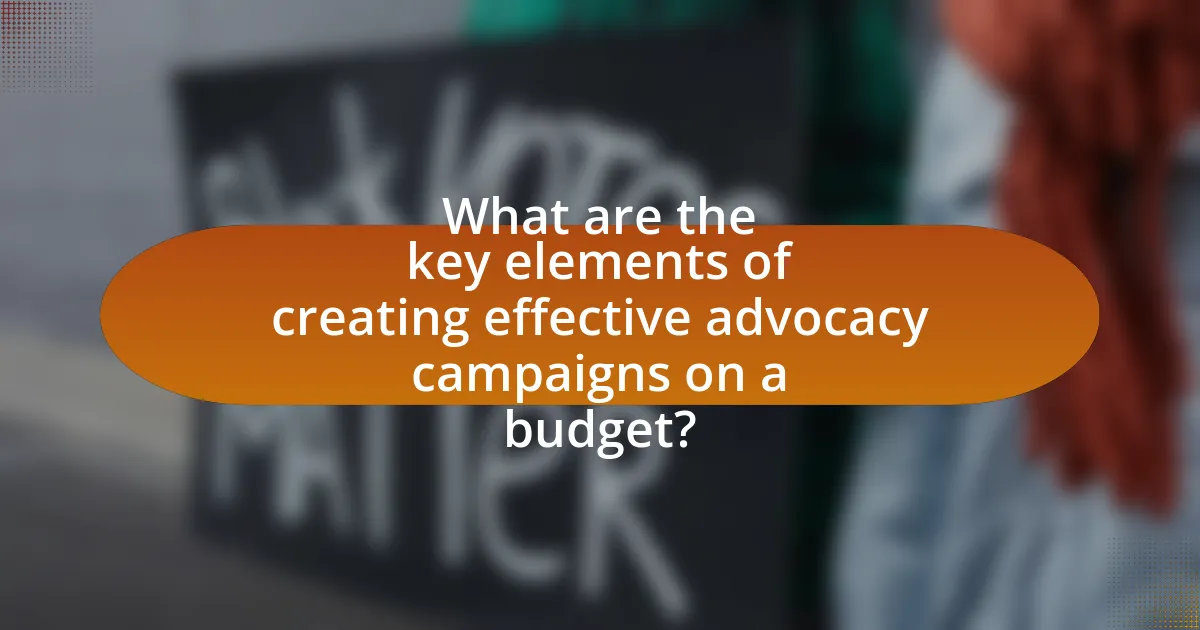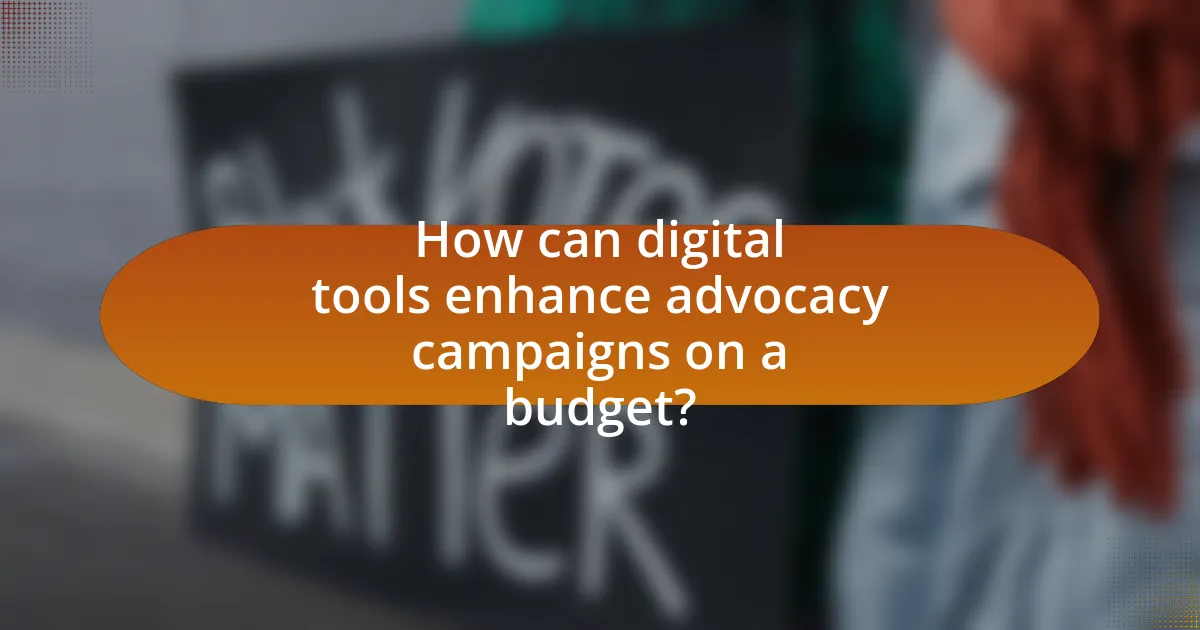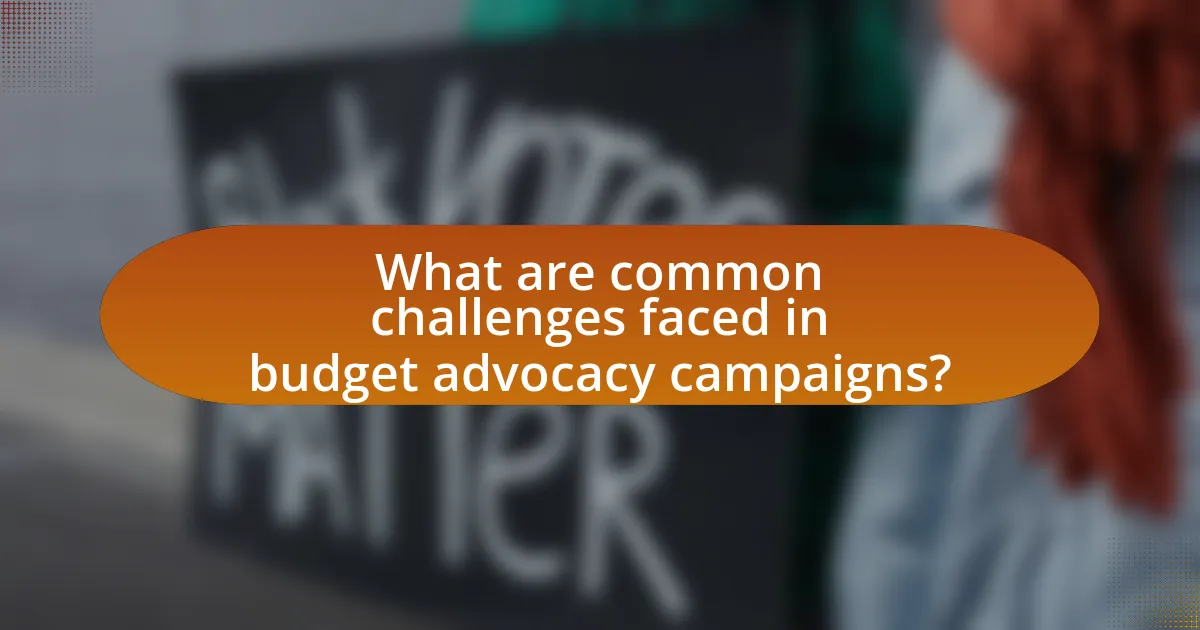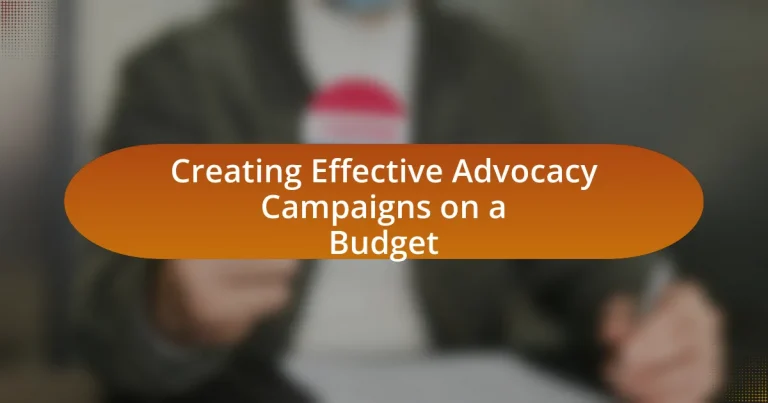Creating effective advocacy campaigns on a budget involves several key elements, including clear messaging, targeted outreach, leveraging social media, building partnerships, and utilizing volunteer support. Understanding the audience enhances campaign effectiveness through tailored messaging, while audience segmentation allows for more impactful communication. Strategies such as prioritizing high-impact activities, grassroots mobilization, and leveraging digital tools can maximize limited resources. Ethical considerations, transparency, and maintaining momentum despite financial constraints are also crucial for successful advocacy efforts. This article provides practical tips and best practices for engaging volunteers and utilizing storytelling to enhance advocacy campaigns within budget limitations.

What are the key elements of creating effective advocacy campaigns on a budget?
The key elements of creating effective advocacy campaigns on a budget include clear messaging, targeted outreach, leveraging social media, building partnerships, and utilizing volunteer support. Clear messaging ensures that the campaign’s goals and values resonate with the audience, which is crucial for engagement. Targeted outreach focuses resources on specific demographics or communities that are most likely to support the cause, maximizing impact. Leveraging social media allows for cost-effective communication and mobilization, as platforms like Facebook and Twitter can reach large audiences without significant financial investment. Building partnerships with other organizations can amplify resources and extend reach, while utilizing volunteer support reduces labor costs and fosters community involvement. These elements collectively enhance the effectiveness of advocacy campaigns even when financial resources are limited.
How can understanding your audience enhance your advocacy campaign?
Understanding your audience enhances your advocacy campaign by allowing for tailored messaging that resonates with their values and concerns. When campaigns align their objectives with the specific interests and demographics of their audience, they increase engagement and support. Research shows that campaigns that utilize audience segmentation can improve their effectiveness by up to 50%, as targeted messages are more likely to inspire action and foster community involvement. By analyzing audience data, such as preferences and behaviors, advocates can craft strategies that not only capture attention but also drive meaningful participation and advocacy outcomes.
What methods can be used to identify and analyze your target audience?
To identify and analyze your target audience, utilize methods such as surveys, social media analytics, and demographic research. Surveys allow direct feedback from potential audience members, providing insights into their preferences and behaviors. Social media analytics tools, like Facebook Insights or Twitter Analytics, offer data on user engagement and demographics, helping to understand audience interests and trends. Demographic research, including studies from sources like the U.S. Census Bureau, provides statistical data on age, gender, income, and education levels, which can be crucial for tailoring advocacy campaigns effectively. These methods collectively enhance the understanding of the target audience, ensuring that campaigns are relevant and impactful.
How does audience segmentation impact campaign messaging?
Audience segmentation significantly enhances campaign messaging by allowing tailored communication that resonates with specific groups. By dividing the audience into distinct segments based on demographics, interests, or behaviors, campaigners can craft messages that address the unique needs and preferences of each group. For instance, a study by the American Marketing Association found that targeted messaging can increase engagement rates by up to 50%, demonstrating the effectiveness of personalized communication. This strategic approach not only improves message relevance but also optimizes resource allocation, making campaigns more efficient and impactful, especially when operating on a budget.
What role does messaging play in advocacy campaigns?
Messaging serves as the cornerstone of advocacy campaigns by effectively communicating the campaign’s goals, values, and calls to action. Clear and compelling messaging helps to engage the target audience, mobilize supporters, and influence public opinion. Research indicates that campaigns with strong, consistent messaging can increase engagement by up to 50%, demonstrating the critical importance of well-crafted communication strategies in achieving advocacy objectives.
How can you craft a compelling message that resonates with your audience?
To craft a compelling message that resonates with your audience, focus on understanding their values, needs, and emotions. Research indicates that messages tailored to the audience’s specific interests and concerns are more likely to engage them effectively. For example, a study by the Nielsen Norman Group found that personalized content can increase user engagement by up to 50%. Additionally, using storytelling techniques can enhance relatability and emotional connection, as narratives are proven to be more memorable than facts alone. By combining audience insights with emotional appeal and storytelling, you can create a message that not only captures attention but also fosters a deeper connection with your audience.
What are the best practices for maintaining consistency in messaging?
The best practices for maintaining consistency in messaging include developing a clear messaging framework, ensuring alignment across all communication channels, and regularly training team members on key messages. A clear messaging framework provides a structured approach that defines core values, mission, and target audience, which helps in delivering uniform messages. Alignment across communication channels, such as social media, email, and public relations, ensures that all platforms convey the same message, reinforcing brand identity. Regular training for team members on key messages ensures that everyone involved in the campaign understands and communicates the same information, which is crucial for maintaining consistency. Research shows that consistent messaging can increase brand recognition by up to 80%, highlighting the importance of these practices in effective advocacy campaigns.
What strategies can be employed to maximize limited resources?
To maximize limited resources in advocacy campaigns, organizations can implement strategies such as prioritizing high-impact activities, leveraging partnerships, and utilizing digital tools. Prioritizing high-impact activities involves focusing on initiatives that yield the greatest return on investment, ensuring that time and funds are allocated to efforts that drive significant results. Leveraging partnerships allows organizations to share resources, expertise, and networks, thereby amplifying their reach without incurring additional costs. Utilizing digital tools, such as social media and email marketing, enables cost-effective communication and engagement with target audiences, facilitating broader outreach while minimizing expenses. These strategies are supported by research indicating that targeted resource allocation and collaboration can enhance campaign effectiveness, even with limited budgets.
How can grassroots mobilization be an effective low-cost strategy?
Grassroots mobilization is an effective low-cost strategy because it leverages community engagement and local networks to drive change without significant financial investment. By utilizing volunteers and local resources, organizations can amplify their message and reach a wider audience through word-of-mouth and social media, which are both cost-effective methods of communication. Historical examples, such as the Civil Rights Movement, demonstrate that grassroots efforts can lead to substantial social change with minimal funding, relying instead on the power of collective action and community solidarity. This approach not only reduces costs but also fosters a sense of ownership and commitment among participants, enhancing the overall impact of advocacy campaigns.
What are the benefits of leveraging partnerships and collaborations?
Leveraging partnerships and collaborations enhances resource efficiency and expands outreach in advocacy campaigns. By pooling resources, organizations can reduce costs associated with campaign activities, such as marketing and event planning. For instance, a study by the Stanford Social Innovation Review found that collaborative efforts can lead to a 30% reduction in operational costs. Additionally, partnerships allow for a broader audience reach, as each partner brings their own network, increasing visibility and engagement. This collective impact can amplify the message and effectiveness of advocacy efforts, ultimately leading to greater success in achieving campaign goals.

How can digital tools enhance advocacy campaigns on a budget?
Digital tools can enhance advocacy campaigns on a budget by providing cost-effective platforms for outreach, engagement, and mobilization. For instance, social media platforms like Facebook and Twitter allow organizations to reach large audiences without significant financial investment, enabling targeted messaging to specific demographics. According to a report by the Pew Research Center, 69% of adults in the U.S. use social media, making it a vital channel for advocacy efforts. Additionally, tools like email marketing services and crowdfunding platforms facilitate direct communication and fundraising, further amplifying campaign reach and impact. These digital solutions not only reduce traditional advertising costs but also enable real-time feedback and engagement, allowing advocates to adjust strategies quickly based on audience response.
What digital platforms are most effective for advocacy campaigns?
Social media platforms, particularly Facebook, Twitter, and Instagram, are the most effective for advocacy campaigns. These platforms enable organizations to reach large audiences quickly and engage users through shares, likes, and comments. For instance, a study by the Pew Research Center found that 69% of adults in the U.S. use Facebook, making it a prime platform for mobilizing support and spreading awareness. Additionally, Twitter’s real-time communication capabilities allow for rapid dissemination of information, while Instagram’s visual content can effectively capture attention and convey messages. These characteristics make these platforms essential tools for successful advocacy efforts.
How can social media be utilized to amplify your message?
Social media can be utilized to amplify your message by leveraging its vast reach and engagement capabilities. Platforms like Facebook, Twitter, and Instagram allow users to share content widely, increasing visibility and interaction with target audiences. For instance, a study by Pew Research Center found that 69% of adults in the U.S. use social media, making it a powerful tool for disseminating information quickly and effectively. By creating shareable content, utilizing hashtags, and engaging with followers, organizations can enhance their message’s impact and foster community involvement.
What are the advantages of using email marketing in advocacy efforts?
Email marketing offers several advantages in advocacy efforts, primarily its cost-effectiveness, targeted reach, and measurable impact. It allows organizations to communicate directly with supporters, fostering engagement and mobilization without the high costs associated with traditional advertising methods. According to a study by the Direct Marketing Association, email marketing has an average return on investment of $42 for every dollar spent, demonstrating its efficiency in reaching and influencing audiences. Additionally, email campaigns can be tailored to specific demographics, ensuring that messages resonate with the intended recipients, which enhances the likelihood of action. This targeted approach, combined with the ability to track open rates, click-through rates, and conversions, provides valuable insights that can inform future advocacy strategies.
How can data analytics improve campaign effectiveness?
Data analytics can improve campaign effectiveness by enabling targeted messaging and optimizing resource allocation. By analyzing demographic data, engagement metrics, and past campaign performance, organizations can identify the most receptive audiences and tailor their messages accordingly. For instance, a study by McKinsey found that companies using data-driven marketing are 23 times more likely to acquire customers and 6 times more likely to retain them. This demonstrates that leveraging data analytics not only enhances audience targeting but also maximizes the return on investment for advocacy campaigns.
What metrics should be tracked to measure campaign success?
To measure campaign success, key metrics include engagement rates, conversion rates, reach, and return on investment (ROI). Engagement rates, which encompass likes, shares, and comments, indicate how well the audience interacts with the campaign content. Conversion rates reflect the percentage of users who take a desired action, such as signing a petition or donating, demonstrating the campaign’s effectiveness in prompting action. Reach measures the total number of unique individuals who see the campaign, providing insight into its visibility. Lastly, ROI quantifies the financial return relative to the campaign’s cost, allowing for assessment of budget efficiency. Tracking these metrics provides a comprehensive view of a campaign’s performance and impact.
How can feedback loops be established to refine campaign strategies?
Feedback loops can be established to refine campaign strategies by systematically collecting and analyzing data from various campaign touchpoints. This involves setting up mechanisms such as surveys, social media monitoring, and performance metrics to gather insights on audience engagement and response. For instance, using tools like Google Analytics can provide quantitative data on website traffic and user behavior, while social media platforms offer qualitative feedback through comments and shares. By regularly reviewing this data, campaign managers can identify what resonates with the audience and make informed adjustments to messaging, targeting, and tactics. Research indicates that campaigns that incorporate feedback loops can improve effectiveness by up to 30%, as they allow for real-time adjustments based on audience reactions.

What are common challenges faced in budget advocacy campaigns?
Common challenges faced in budget advocacy campaigns include limited financial resources, lack of stakeholder engagement, and insufficient data to support claims. Limited financial resources restrict the ability to reach wider audiences and implement comprehensive strategies, as evidenced by a study from the Center for Budget and Policy Priorities, which highlights that organizations often struggle to allocate funds effectively. Lack of stakeholder engagement can lead to diminished support and advocacy impact, as noted in research by the National Council of Nonprofits, which emphasizes the importance of building coalitions. Insufficient data undermines the credibility of advocacy efforts, making it difficult to persuade decision-makers; the Urban Institute’s findings indicate that data-driven campaigns are more successful in influencing budgetary decisions.
How can limited funding impact campaign reach and effectiveness?
Limited funding significantly restricts campaign reach and effectiveness by limiting resources for outreach, advertising, and engagement strategies. When financial resources are constrained, campaigns often cannot afford to utilize multiple channels, such as social media ads, print materials, or event hosting, which are essential for maximizing visibility. For instance, a study by the Pew Research Center found that campaigns with higher budgets can reach up to 50% more potential supporters through targeted advertising compared to those with limited funding. Additionally, insufficient funds can lead to reduced staffing, which diminishes the ability to engage with the audience effectively and respond to inquiries, further impacting the overall effectiveness of the campaign.
What strategies can be implemented to overcome funding limitations?
To overcome funding limitations in advocacy campaigns, organizations can implement strategies such as leveraging partnerships, utilizing social media for cost-effective outreach, and focusing on grassroots fundraising. Leveraging partnerships allows organizations to share resources and amplify their message, which can lead to increased visibility and support without significant financial investment. Utilizing social media platforms enables campaigns to reach a wider audience at minimal cost, as these platforms often provide free tools for engagement and promotion. Additionally, focusing on grassroots fundraising, such as community events or crowdfunding, can mobilize local support and generate funds directly from individuals who are passionate about the cause. These strategies are effective as they maximize resource utilization while minimizing expenses, allowing campaigns to thrive even with limited funding.
How can advocacy groups maintain momentum despite financial constraints?
Advocacy groups can maintain momentum despite financial constraints by leveraging grassroots support and utilizing digital platforms for outreach. Grassroots mobilization allows organizations to engage community members who can contribute time, skills, and resources, fostering a sense of ownership and commitment to the cause. For instance, successful campaigns often rely on volunteer-driven initiatives, which can significantly reduce operational costs while enhancing community involvement. Additionally, digital platforms such as social media enable advocacy groups to reach a wider audience at minimal expense, facilitating the dissemination of information and mobilization of supporters. According to a report by the Pew Research Center, 69% of adults in the U.S. use social media, providing a vast potential audience for advocacy messages. By combining grassroots efforts with effective digital strategies, advocacy groups can sustain their activities and influence even when financial resources are limited.
What are the ethical considerations in budget advocacy campaigns?
Ethical considerations in budget advocacy campaigns include transparency, accountability, and the representation of marginalized voices. Transparency ensures that stakeholders understand how funds are allocated and used, fostering trust and credibility. Accountability involves being responsible for the outcomes of the campaign, ensuring that promises made are fulfilled and that there is a mechanism for addressing failures. Additionally, representing marginalized voices is crucial to avoid perpetuating inequalities; campaigns should prioritize inclusivity to ensure that all affected communities are heard and considered in the advocacy process. These ethical principles are essential for maintaining integrity and effectiveness in budget advocacy efforts.
How can transparency be maintained while operating on a budget?
Transparency can be maintained while operating on a budget by implementing clear communication strategies and regular reporting practices. Establishing a budget that outlines specific allocations for each campaign component allows stakeholders to understand financial decisions. Regular updates on spending and progress, such as monthly financial reports, foster accountability and trust among team members and supporters. Research indicates that organizations that practice transparency in financial matters are more likely to gain public trust, as evidenced by a 2020 study from the Nonprofit Finance Fund, which found that 85% of respondents valued transparency in nonprofit financial practices.
What are the potential pitfalls of low-cost advocacy efforts?
Low-cost advocacy efforts can lead to several potential pitfalls, including limited reach, reduced credibility, and inadequate resources for effective messaging. Limited reach occurs when budget constraints restrict the ability to engage a broad audience, resulting in a smaller impact. Reduced credibility can stem from the perception that low-cost campaigns lack professionalism or thoroughness, which may undermine trust among stakeholders. Inadequate resources can hinder the development of high-quality materials and strategic planning, ultimately affecting the campaign’s effectiveness. Research indicates that campaigns with insufficient funding often struggle to achieve their goals, as evidenced by a study from the Stanford Social Innovation Review, which highlights that resource allocation significantly influences advocacy outcomes.
What practical tips can enhance the success of advocacy campaigns on a budget?
To enhance the success of advocacy campaigns on a budget, organizations should focus on leveraging social media, building partnerships, and utilizing grassroots mobilization. Social media platforms allow for cost-effective outreach, enabling campaigns to reach a wider audience without significant financial investment. For instance, campaigns that utilize Facebook and Twitter can engage thousands at minimal cost, as evidenced by the 2016 U.S. presidential election, where social media played a crucial role in mobilizing voters. Building partnerships with local organizations can amplify resources and reach, as collaborative efforts often share costs and expand networks. Grassroots mobilization, such as organizing community events or utilizing volunteers, can also significantly reduce expenses while fostering community engagement and support. These strategies collectively contribute to the effectiveness of advocacy campaigns while adhering to budget constraints.
How can storytelling be effectively used in budget advocacy campaigns?
Storytelling can be effectively used in budget advocacy campaigns by creating emotional connections that resonate with the audience, thereby enhancing engagement and support. When advocates share personal narratives or case studies that illustrate the impact of budget decisions on individuals or communities, they can evoke empathy and motivate action. For instance, a campaign that highlights a family’s struggle due to cuts in social services can humanize the issue, making it more relatable and urgent. Research shows that stories are 22 times more memorable than facts alone, which underscores their power in influencing public opinion and policy decisions.
What are the best practices for engaging volunteers in advocacy efforts?
The best practices for engaging volunteers in advocacy efforts include clear communication of goals, providing training and resources, recognizing contributions, and fostering a sense of community. Clear communication ensures that volunteers understand the objectives and their roles, which increases motivation and effectiveness. Providing training equips volunteers with the necessary skills and knowledge, enhancing their confidence and ability to advocate effectively. Recognizing contributions, whether through public acknowledgment or rewards, boosts morale and encourages continued involvement. Fostering a sense of community among volunteers creates a supportive environment, leading to higher retention rates and more impactful advocacy efforts. Research indicates that organizations that implement these practices see increased volunteer satisfaction and engagement, which directly correlates with the success of advocacy campaigns.


